 Relativistic effects
Relativistic effects
The Schrodinger equation, taken as the starting point for this section, is of course
the non-relativistic one. In view of the fact that the characteristic energy in the hydrogen atom,
the Rydberg energy, scales like (alpha)2
(hyperlink to introduction) times the rest-mass,
the electron relativistic effects are small. The kinetic energy operator, which is classically
p2/2m, can relativistically be written in a power series expansion,
with the classical term as the first, added by a term proportional to p4.
Since the wave functions of the Hydrogen atom are eigen functions of the operator
p2, they are also eigenfunctions of the operator p4, so that
the first and higher order relativistic corrections can be easily calculated.
Note that the contribution of relativistic (kinetic) effects
are equally large as the spin-orbit interaction effects in hydrogen.
Math: derivation.
A comprehensive first priciples description of the hydrogen atom from the relativistic
point of view is given in terms of the
Dirac equation, in which automatically
the effects of electron spin are included.
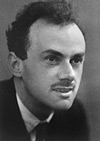 Paul Dirac
Nobel Prize laureate 1933
Paul Dirac
Nobel Prize laureate 1933
 Quantum electrodynamics effects and the Lamb shift
Quantum electrodynamics effects and the Lamb shift
Even the relativistic Dirac equation does not give an exact treatment of the hydrogen atom
for the reason that the theory of quantum mechanics should be extended somewhat with the
effects of the self-energy of the electron and the vacuum polarisation. The theory
of Quantum Electrodynamics, developed by Tomonaga, Feynman, and Schwinger, is the theory
superseeding quantum mechanics. It gives the most accurate description of the structure
of matter and includes these effects.
One result of QED is the deviation of the g-factor for the electron from 2.
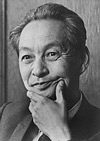
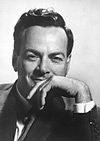
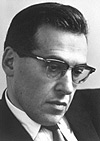
Tomonaga, Feynman and Schwinger
Nobel Prize laureates 1965
One of the effects of QED is the splitting between the 2s and 2p levels in atomic hydrogen,
first observed
by Lamb and Retherford by means of inducing a microwave transition between these levels.
As mentioned, these levels are expected to be degenerate in the framework of the Schrodinger
equation.
From an advanced analysis within QED it can be
shown that the self-energy of the electron, or the electron mass renormalization,
gives the dominant contribution to the Lamb shift of 1060 MHz.
Later the Lamb shift was also observed via the technique of
laser saturation spectroscopy.
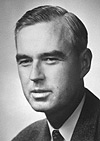 W.E. Lamb
Nobel Prize laureate 1955
W.E. Lamb
Nobel Prize laureate 1955
Measurements of these small effects in the spectra of atoms has become an active field of
physics. Also at Vrije Universiteit an important contribution has been made in this area
by the measurement of the Lamb shift in the ground state of the
Helium atom.
 Hyperfine structure
Hyperfine structure
The nucleus of the hydrogen atom, the proton, has a nuclear spin of IH = 1/2.
The associated magnetic dipole moment interacts with the spin of the electron
via a magnetic coupling, similar to that of the spin-orbit interaction.
This interaction gives rise to a splitting of the ground state of hydrogen
|n=0, l=0, j=1/2> into a F=1 level and a F=0 level,
F being the total angular momentum including the nuclear spin.
 It can be shown that the splitting, named the hyperfine splitting, is 1420 MHz.
It can be shown that the splitting, named the hyperfine splitting, is 1420 MHz.
Calculation of hyperfine structure in hydrogen.
 Furthermore it can be calculated that the spontaneous decay rate of the upper F=1 level is
A10 = 3 x 10-15 s-1.
This decay rate corresponds to an upper state lifetime of 107 years.
So this is a very weak transition, related to the fact that an electric dipole transition
between the hyperfine levels is forbidden; both levels have l=0 and therefore the same
parity.
Furthermore it can be calculated that the spontaneous decay rate of the upper F=1 level is
A10 = 3 x 10-15 s-1.
This decay rate corresponds to an upper state lifetime of 107 years.
So this is a very weak transition, related to the fact that an electric dipole transition
between the hyperfine levels is forbidden; both levels have l=0 and therefore the same
parity.
Math: Calculation of decay of F=1 level (difficult).
 The transition frequency of 1420 MHz corresponds to a wavelength of 21 cm.
Although the transition probability in a single atom is very weak, the abundance
of H-atoms in the universe is so high that the 21 cm line is a spectral feature that is
readily observable with
radio telescopes. In the Netherlands there has been a strong activity
in radio-astronomy since the 1950's, centered around the observatory in
Westerbork-Dwingelo.
The transition frequency of 1420 MHz corresponds to a wavelength of 21 cm.
Although the transition probability in a single atom is very weak, the abundance
of H-atoms in the universe is so high that the 21 cm line is a spectral feature that is
readily observable with
radio telescopes. In the Netherlands there has been a strong activity
in radio-astronomy since the 1950's, centered around the observatory in
Westerbork-Dwingelo.
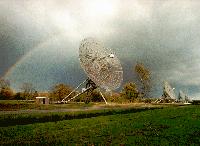 Westerbork-Dwingelo Radiotelescope
Westerbork-Dwingelo Radiotelescope
 In fact
Sky surveys of 21 cm line
can be made, hence mapping out the hydrogen in the universe.
In fact
Sky surveys of 21 cm line
can be made, hence mapping out the hydrogen in the universe.
 Last change: 16 February 2001
Last change: 16 February 2001
Math: derivation.
A comprehensive first priciples description of the hydrogen atom from the relativistic point of view is given in terms of the Dirac equation, in which automatically the effects of electron spin are included.
 Paul Dirac
Nobel Prize laureate 1933
Paul Dirac
Nobel Prize laureate 1933


Tomonaga, Feynman and Schwinger Nobel Prize laureates 1965
One of the effects of QED is the splitting between the 2s and 2p levels in atomic hydrogen, first observed by Lamb and Retherford by means of inducing a microwave transition between these levels. As mentioned, these levels are expected to be degenerate in the framework of the Schrodinger equation. From an advanced analysis within QED it can be shown that the self-energy of the electron, or the electron mass renormalization, gives the dominant contribution to the Lamb shift of 1060 MHz. Later the Lamb shift was also observed via the technique of laser saturation spectroscopy.
 W.E. Lamb
Nobel Prize laureate 1955
W.E. Lamb
Nobel Prize laureate 1955Measurements of these small effects in the spectra of atoms has become an active field of physics. Also at Vrije Universiteit an important contribution has been made in this area by the measurement of the Lamb shift in the ground state of the Helium atom.
 It can be shown that the splitting, named the hyperfine splitting, is 1420 MHz.
It can be shown that the splitting, named the hyperfine splitting, is 1420 MHz.Calculation of hyperfine structure in hydrogen.
 Furthermore it can be calculated that the spontaneous decay rate of the upper F=1 level is
A10 = 3 x 10-15 s-1.
This decay rate corresponds to an upper state lifetime of 107 years.
So this is a very weak transition, related to the fact that an electric dipole transition
between the hyperfine levels is forbidden; both levels have l=0 and therefore the same
parity.
Furthermore it can be calculated that the spontaneous decay rate of the upper F=1 level is
A10 = 3 x 10-15 s-1.
This decay rate corresponds to an upper state lifetime of 107 years.
So this is a very weak transition, related to the fact that an electric dipole transition
between the hyperfine levels is forbidden; both levels have l=0 and therefore the same
parity.Math: Calculation of decay of F=1 level (difficult).
 The transition frequency of 1420 MHz corresponds to a wavelength of 21 cm.
Although the transition probability in a single atom is very weak, the abundance
of H-atoms in the universe is so high that the 21 cm line is a spectral feature that is
readily observable with
radio telescopes. In the Netherlands there has been a strong activity
in radio-astronomy since the 1950's, centered around the observatory in
Westerbork-Dwingelo.
The transition frequency of 1420 MHz corresponds to a wavelength of 21 cm.
Although the transition probability in a single atom is very weak, the abundance
of H-atoms in the universe is so high that the 21 cm line is a spectral feature that is
readily observable with
radio telescopes. In the Netherlands there has been a strong activity
in radio-astronomy since the 1950's, centered around the observatory in
Westerbork-Dwingelo.
 Westerbork-Dwingelo Radiotelescope
Westerbork-Dwingelo Radiotelescope In fact
Sky surveys of 21 cm line
can be made, hence mapping out the hydrogen in the universe.
In fact
Sky surveys of 21 cm line
can be made, hence mapping out the hydrogen in the universe.